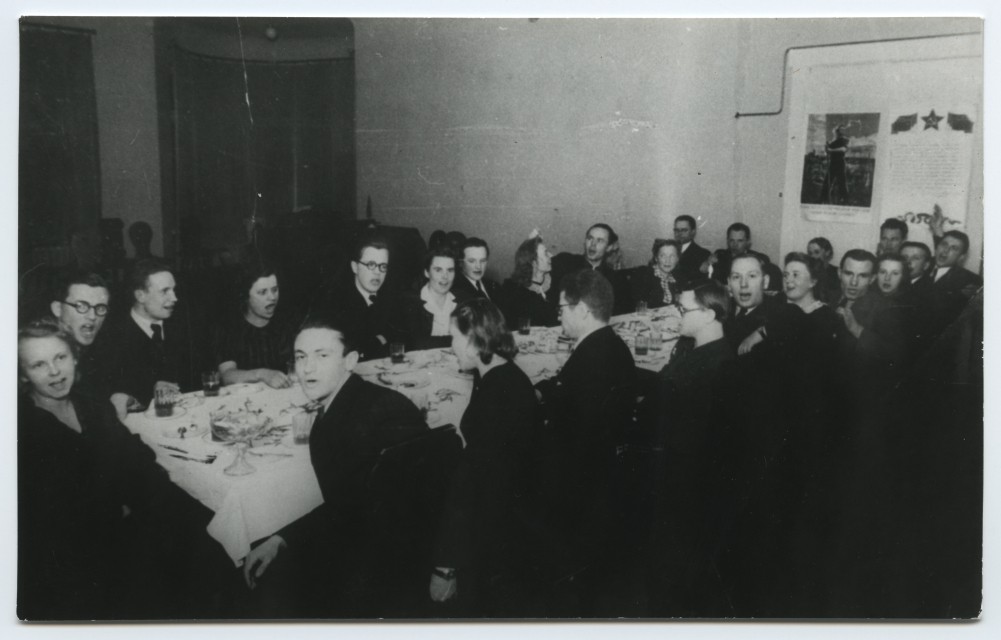KP 15
EST:
Vanemuise 54 konvendihoone
1912. aastal ostis kinnistu Moskva kaupmees Georg Lellep, kes lasi siia ehitada juugendvilla. 1933. aastal müüs vahepeal vahetunud omanik maja koos krundiga korporatsioonile Fraternitas Estica konvendihooneks. Nõukogude okupatsiooni alguses 1940. aastal suleti üliõpilasorganisatsioonid ja nende hooned riigistati. Formaalselt läksid kõik 11 korporatsioonihoonet ülikoolile, ent tegelikult jäi ülikooli käsutusse vaid see hoone siin. 1940. aasta sügisel asutati majja 35 kohaga meesüliõpilaste internaat. Pärast teist maailmasõda kasutasid maja paarikümne aasta jooksul haldushoonena Vanemuise teater ja Tartu harrastuskultuurikollektiivid. 1967.–1994. aastal tegutses siin Eesti Televisiooni Tartu stuudio. Taastatud korporatsioonile Fraternitas Estica tagastati maja 1996. aastal.
Ajaloo osakonna õpilane Voldemar Pihlau meenutab:
„Meil elas ühiselamus vaid üheksa inimest – kaheksa üliõpilast ja üks õppejõud. […] Omavaheline läbisaamine oli hea ja kontaktid tihedad. Väljaarvatud kahe filoloogiga, kes armastasid olla omaette. Ühel neist oli kombeks kuulata ukse taga meie jutuajamisi, teine kannatas otsekui tagakiusamismaania all. Elas üksinda toas ja õhtul kuhjas seestpoolt ukse ette toolivirna, et teiste tuppatulek (ustel puudusid ju võtmed) teeks kolinat. Ühiselamu võinuks mahutada hoopis rohkem noori kui seal elas. Ka olmetingimused olid rahuldavad. Aga üliõpilaste hulgas oli levinud arvamus, et tudeng peab tingimata elama omaette toas või korteris.“

ENG:
Vanemuise 54 building
In 1912, Georg Lellep, a businessman from Moscow, bought the land here and built an Art Nouveau-style villa on it. The property later changed hands, and in 1933, the new owner sold the house and land to the Fraternitas Estica to be used as their own premises. All student organisations were shut down and their buildings nationalised at the start of the Soviet occupation in 1940. Formally, all 11 fraternity buildings were granted to the university, but it was only this one that the university actually got. In the autumn of 1940, the building was turned into a 35-bed dormitory for male students. For a decade or so after the Second World War, it was used as an administrative building by the Vanemuine Theatre and Tartu’s recreational culture organisations. From 1967 to 1994, it housed the Tartu studio of Estonian Television. The house was returned to the newly reformed Fraternitas Estica in 1996.
History student Voldemar Pihula recalls, “There were just nine of us living in the building – eight students and one faculty member. […] We saw everyone quite often and got along well, apart from two philologists who loved to keep to themselves. One of them had a habit of eavesdropping on our conversations. The other seemed to suffer from a persecution complex. He kept entirely to himself. At night, he’d pile chairs up in front of the door (since the doors didn’t have keys) so they would make a noise if anyone else came in. The building would easily have fit more students than the number living there. Even the conditions were satisfactory. But there was this idea among the students that they had to live in separate rooms or apartments.”



